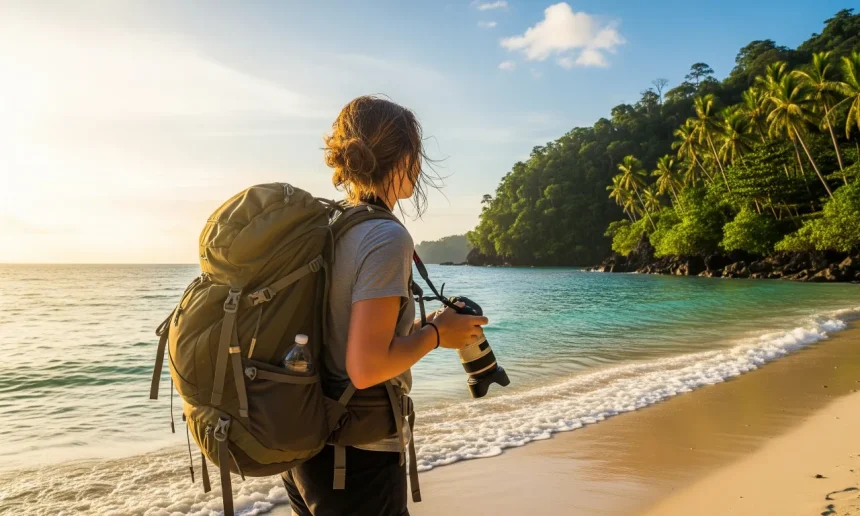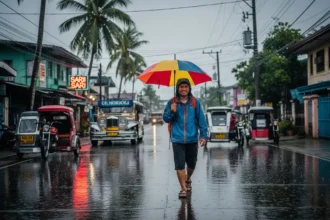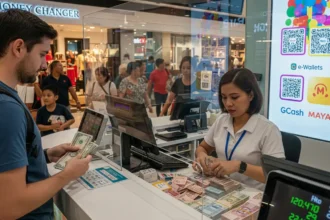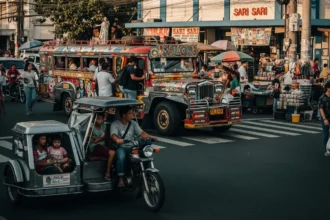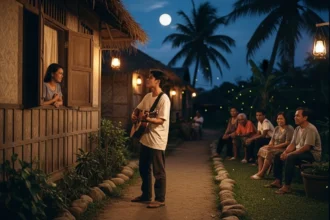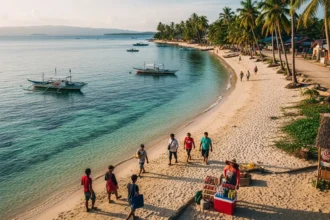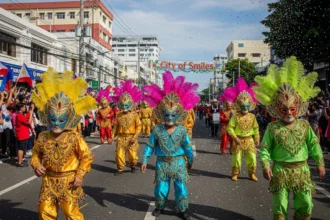🎒 The Forbidden Fruit: A Journey into Mindanao’s Heart
Let’s be honest, my friend. When you hear the word “Mindanao,” what is the first thing that comes to mind? For many, the answer is not white sand beaches or lush green mountains. The answer is headlines. It’s the headlines of conflict, of danger, and of a region that is best left alone. It’s a stereotype that has been ingrained in our minds by decades of media coverage.
- 🎒 The Forbidden Fruit: A Journey into Mindanao’s Heart
- 🧐 Debunking the Headlines: 5 Myths About Mindanao
- 🏝️ The Truth Revealed: Mindanao is a Paradise Awaiting Discovery
- Top 5 Must-Visit Backpacking Spots in Mindanao
- 🧭 The Traveler’s Compass: Navigating Culture and Customs
- 🎒 The Backpacking Blueprint: Budgeting for Your Adventure
- ⚖️ Myth vs. Reality: A Final Look
- 🤔 FAQs about Backpacking Mindanao
- The Final Invitation: Unwrapping a Hidden Gem
- 🧭 References
I, myself, admit to having this preconceived notion. But something shifted. I decided to pack my bag and see for myself. I embarked on a journey into the heart of the Philippines’ most misunderstood region. My experience, I am happy to report, was nothing like the headlines. The reality, I found, was a beautiful, welcoming, and a truly unforgettable one. This is a story of that journey. This is an exposé on the truth. This is a guide to Mindanao myths and reality.
This isn’t just a travelogue. This is an invitation. It is an invitation to look beyond the headlines. It is an invitation to experience a side of the Philippines that you have never seen before. We are going to debunk the myths. We are going to show you the reality. We are going to give you a guide to backpacking Mindanao. We will talk about the best places to visit. We will talk about the best time to visit. We will talk about the best way to get there. We will talk about the best way to get around. So, get ready, my friend. Get ready to embark on a journey that will not only change your perception of Mindanao but will also change your perception of yourself.
🧐 Debunking the Headlines: 5 Myths About Mindanao
The media, for decades, has portrayed Mindanao as a single, war-torn zone. It is a portrayal that has created a lot of fear. It has created a lot of misconceptions. The reality, however, is a different story. The reality is that Mindanao is a massive, diverse, and a beautiful island group. It is a region that is filled with friendly people, rich cultures, and breathtaking natural wonders. The vast majority of the region is safe. Most areas are peaceful. Most people are welcoming. We have to debunk these myths. We have to expose the truth. We have to show you the reality.
The overgeneralization of Mindanao is a betrayal. It is a betrayal of the people. It is a betrayal of the region. The truth is that Mindanao is not a single entity. It is a collection of provinces, each with its own unique culture, its own unique history, and its own unique beauty. A conflict in one area does not mean that the entire region is at war. This is a crucial distinction. It is a distinction that is often lost in the media’s portrayal. We have to be a more discerning traveler. We have to look beyond the headlines.
⚔️ Myth 1: Mindanao is a single, war-torn zone.
The media often portrays Mindanao as a single, war-torn zone. The reality, however, is that Mindanao is a massive island group, with a land area larger than that of South Korea or Portugal. A conflict in one small, specific area does not mean that the entire region is in turmoil. The vast majority of the region is peaceful. Most areas are safe for travel. The military has a strong presence in some of the more sensitive areas. They have ensured that the tourist destinations are safe.
😠 Myth 2: Locals are hostile to outsiders.
This is a complete misconception. The locals are some of the most friendly and welcoming people you will ever meet. They are warm. They are hospitable. They are proud of their region. They are always happy to welcome a tourist. My experience with the locals was a beautiful one. They were always happy to help. They were always happy to share their stories. They were always happy to share their food.
💰 Myth 3: It’s too expensive to travel there.
This is a myth that is often debunked by the reality. Backpacking Mindanao is incredibly affordable. The cost of food, transportation, and accommodation is very cheap. You can travel for a few hundred pesos a day. You can find a room for a few hundred pesos a night. The only expensive part of the trip is the flight to get there. Once you are there, the cost of living is very low.
🗺️ Myth 4: There’s nothing to see but conflict.
This is the biggest misconception of all. Mindanao is a paradise. It is a region that is filled with breathtaking natural wonders. It is a region that is filled with beautiful beaches, lush green mountains, and unique geological formations. It is a region that is filled with rich cultures, unique festivals, and delicious food. It is a region that is a paradise for a backpacker.
📝 Myth 5: You need a special permit to travel.
This is a myth that is often circulated by people who have not been there. You do not need a special permit to travel to the tourist destinations in Mindanao. The military has a strong presence in some of the more sensitive areas. They have ensured that the tourist destinations are safe. The only thing you need to travel is a ticket and a passport.
🏝️ The Truth Revealed: Mindanao is a Paradise Awaiting Discovery
Mindanao is a paradise. It is a region that is filled with breathtaking natural wonders. The region is home to some of the most beautiful beaches in the Philippines. It is home to some of the most beautiful mountains in the Philippines. It is home to some of the most unique geological formations in the Philippines. It is a region that is a paradise for a backpacker. The region is filled with friendly people, rich cultures, and a delicious cuisine. It is a region that is a paradise for a traveler who is looking for a real adventure.
The beauty of Mindanao is a powerful force. It is a force that will change your perception of the region. It is a force that will change your perception of yourself. It is a force that will leave you with a sense of wonder. The beauty of Mindanao is not a secret. It is a gift. It is a gift that is waiting to be unwrapped.
Top 5 Must-Visit Backpacking Spots in Mindanao
Mindanao isn’t just the “land of promise” – for backpackers, it’s a land of endless discovery. From sleepy surf towns that became global sensations, to hidden highland provinces where waterfalls roar and mountains stretch beyond the horizon, the island offers something different from the usual Luzon and Visayas trails. Here are five backpacking spots in Mindanao that deserve a spot on your bucket list.
🌊 Siargao, Surigao del Norte: The Surfer’s Paradise
Once a sleepy fishing village, Siargao has grown into the surf capital of the Philippines – but there’s more to it than Cloud 9’s famous waves. Backpackers flock here not only for surfing but also for island-hopping, motorbike adventures, and laid-back nights in hostels.
- What to Do: Ride a motorbike through coconut palm forests, swim in Magpupungko Rock Pools, and join an island-hopping trip to Guyam, Naked, and Daku Islands.
- Backpacker Tip: Many hostels organize communal dinners or live music nights – the perfect way to meet fellow travelers.
- Why Go: It’s both lively and raw, where you can surf in the morning and spend the evening with friends watching sunsets over General Luna’s boardwalk.
🏙 Davao City, Davao del Sur: Culture, Food, and Adventure
Davao City offers a different kind of backpacking experience – less about wild nights, more about immersing yourself in local life. It’s one of the country’s safest cities, making it a great base for solo travelers.
- What to Do: Visit Mount Apo Natural Park, explore Eden Nature Park, or relax at Samal Island just 15 minutes away by boat.
- Food to Try: Durian, mangosteen, pomelo, and the city’s legendary tuna kinilaw. Don’t miss the bustling Roxas Night Market.
- Festivals: If you’re around in August, join the colorful Kadayawan Festival, a week-long celebration of Davao’s diverse indigenous cultures.
- Why Go: It’s the rare city that combines modern comforts with quick access to both mountains and the sea.
🌋 Camiguin: Island Born of Fire
They call Camiguin the “Island Born of Fire” because it’s home to seven volcanoes in one tiny island. But don’t let its size fool you – Camiguin is a backpacker’s dream for slow travel.
- What to Do: Trek up Mt. Hibok-Hibok, dive in Sunken Cemetery, dip in hot and cold springs, and take a boat to White Island Sandbar.
- Why Backpackers Love It: It’s small enough to explore by motorbike in a day, but the island rewards those who stay longer with waterfalls, jungle hikes, and a relaxed vibe.
- Backpacker Tip: Join locals for lanzones season in October – Camiguin’s sweet lanzones fruit is one of the best in the country.
🌊 Cagayan de Oro, Misamis Oriental: The City of Golden Friendship
Backpackers in Cagayan de Oro (CDO) find themselves in the adventure capital of Northern Mindanao. Known as the “City of Golden Friendship,” it’s a place where adrenaline and warm hospitality meet.
- What to Do: Experience whitewater rafting on the Cagayan River, trek Mapawa Nature Park, or do a side trip to Dahilayan Adventure Park for Asia’s longest zipline.
- Backpacker Vibe: Budget-friendly hostels make it easy to base yourself here while exploring neighboring provinces like Bukidnon or Iligan.
- Why Go: If you’re chasing thrills, this is where your Mindanao backpacking trip really picks up speed.
🌄 Bukidnon Province: Highlands, Waterfalls, and Festivals
For those who want to trade beaches for mountains, Bukidnon is Mindanao’s highland escape. Known as the country’s “food basket,” it’s a province of rolling hills, pineapple plantations, and misty peaks.
- What to Do: Trek Mt. Dulang-Dulang (the country’s second-highest peak), chase waterfalls in Impasug-ong, or simply take in the panoramic views at Dahilayan.
- Festivals: The Kaamulan Festival in Malaybalay celebrates Bukidnon’s seven indigenous tribes – a rare cultural immersion backpackers shouldn’t miss.
- Why Go: Bukidnon feels far removed from crowded tourist trails. Here, you’ll encounter authentic highland culture and landscapes that rival Sagada or Baguio, but with fewer visitors.
🧭 The Traveler’s Compass: Navigating Culture and Customs
Mindanao is a region that is rich in culture. It is a region that is home to a diverse population of indigenous people, Muslims, and Christians. The region is filled with a unique history. It is filled with a unique customs. It is filled with a unique traditions. The region is a paradise for a traveler who is looking for a cultural experience.
The best way to travel is with respect. The best way to travel is with an open mind. The best way to travel is with a sense of curiosity. We have to be a more discerning traveler. We have to look beyond the headlines. We have to look beyond the stereotypes. We have to be a more respectful traveler. We have to respect the local customs. We have to respect the local traditions.
Do’s and Don’ts for a Respectful Trip
- Do be respectful of Muslim traditions: Do not wear revealing clothes in a mosque. Do not bring alcohol in a Muslim community. Do not eat pork in a Muslim community.
- Do ask for permission: Do not take a picture of a local without their permission. Do not enter a local’s home without their permission.
- Do be mindful of local customs: Do not point with your finger. Do not talk loudly in a public place. Do be mindful of your language.
- Don’t over-generalize: A conflict in one small area does not mean that the entire region is in turmoil.
- Don’t talk about politics: Politics is a very sensitive topic in the region. Do not engage in a political debate.
🎒 The Backpacking Blueprint: Budgeting for Your Adventure
Backpacking Mindanao is incredibly affordable. The cost of food, transportation, and accommodation is very cheap. You can travel for a few hundred pesos a day. You can find a room for a few hundred pesos a night. The only expensive part of the trip is the flight to get there. Once you are there, the cost of living is very low.
The best way to travel is with a budget. The best way to travel is with a plan. The best way to travel is with a sense of adventure. We have to be a more discerning traveler. We have to look beyond the headlines. We have to look beyond the stereotypes. We have to be a more budget-conscious traveler.
Backpacking Budget Breakdown (per day)
Logistics: Getting Around Mindanao
Getting around Mindanao is easy and affordable. The region is filled with a wide network of buses, jeepneys, and habal-habal (motorcycle taxis). The best way to get around is with a sense of adventure. The best way to get around is with an open mind. The best way to get around is with a sense of curiosity. We have to be a more discerning traveler. We have to look beyond the headlines. We have to look beyond the stereotypes. We have to be a more resourceful traveler.
Best Time to Visit: Weather, Festivals, and Feasts
The best time to visit Mindanao is from December to February, when the weather is cool and dry. The summer months, from March to May, can be very hot. The rainy season, from June to November, can be a bit unpredictable. The region is filled with a wide variety of festivals. The region is filled with a wide variety of feasts. The best way to travel is with a sense of adventure. The best way to travel is with an open mind. The best way to travel is with a sense of curiosity.
⚖️ Myth vs. Reality: A Final Look
The media’s portrayal of Mindanao is a myth. The reality, however, is a beautiful and a truly unforgettable one. The region is filled with a rich culture. It is filled with a beautiful natural wonders. It is filled with a friendly people. The region is a paradise for a backpacker. The region is a paradise for a traveler who is looking for a real adventure. We have to be a more discerning traveler. We have to look beyond the headlines. We have to look beyond the stereotypes. We have to be a more resourceful traveler.
The overgeneralization of Mindanao is a betrayal. It is a betrayal of the people. It is a betrayal of the region. The truth is that Mindanao is not a single entity. It is a collection of provinces, each with its own unique culture, its own unique history, and its own unique beauty. A conflict in one area does not mean that the entire region is at war. This is a crucial distinction. It is a distinction that is often lost in the media’s portrayal. We have to be a more discerning traveler. We have to look beyond the headlines.
🤔 FAQs about Backpacking Mindanao
Q1: Is it safe to backpack in Mindanao? A: Yes, it is safe to backpack in Mindanao, especially in major tourist areas like Siargao, Davao City, Camiguin, and Cagayan de Oro. The key is to do your research, stay informed about specific areas, and be mindful of your surroundings.
Q2: Do you need travel insurance for Mindanao? A: Travel insurance is always a good idea for any trip, regardless of the destination. It provides peace of mind and covers unexpected events like medical emergencies, flight cancellations, or lost luggage.
Q3: Is it possible to travel to Mindanao alone? A: Yes, it is possible. Mindanao is very welcoming to solo travelers. However, it is always a good idea to inform a friend or family member of your itinerary and to stay in hostels or guesthouses where you can meet other travelers.
Q4: Do I need to speak Filipino to travel in Mindanao? A: While a basic understanding of Filipino can be helpful, it is not essential. English is widely spoken in major cities and tourist areas. Learning a few local phrases, like salamat (thank you), can also be a great way to connect with the locals.
Q5: What are the best places to visit in Mindanao for a beginner backpacker? A: For a beginner backpacker, I would recommend starting with Siargao for its stunning beaches, Davao City for its urban convenience and proximity to nature, or Camiguin for its unique volcanic landscapes.
Q6: How can I find the most affordable accommodations? A: You can find affordable accommodations by staying in hostels or budget guesthouses. You can also try looking for accommodations in less touristy areas.
Q7: Is it true that public transportation is unreliable in Mindanao? A: No, it is not true. The public transportation system in Mindanao is very efficient and affordable. You can easily get around the region with a wide network of buses, jeepneys, and habal-habal.
Q8: What is the emotional toll of traveling to Mindanao? A: The emotional toll of traveling to Mindanao can be a profound one. It can challenge your preconceived notions. It can change your perception of the region. It can change your perception of yourself.
Q9: What is the most unique cultural experience in Mindanao? A: The most unique cultural experience is to attend a local festival. Mindanao is home to a wide variety of festivals, from the colorful Kadayawan Festival in Davao to the unique Lanzones Festival in Camiguin.
Q10: Is it a betrayal to not travel to Mindanao? A: No, it is not a betrayal. The choice to travel is a personal one. However, to not travel to Mindanao is to miss out on a side of the Philippines that is beautiful, rich in culture, and a truly unforgettable one.
The Final Invitation: Unwrapping a Hidden Gem
The Mindanao myths and reality are two different stories. The media’s portrayal is a story of conflict and of danger. The reality is a story of a paradise. It is a story of a region that is filled with a rich culture, a beautiful natural wonders, and a friendly people. The choice to travel is a personal one. But to not travel to Mindanao is to miss out on a side of the Philippines that is beautiful, rich in culture, and a truly unforgettable one.
So, go ahead. Pack your bags. Book that flight. And embark on a journey that will not only change your perception of Mindanao but will also change your perception of yourself. Mindanao is not a destination. It is an experience. It is an experience that is waiting to be unwrapped.
🧭 References
-
Philippine News Agency – Debunking misconceptions and highlighting growth
-
Mindanao Times – World Travel Index: Davao City is Philippines’ second safest
-
Arapatria – Northern Mindanao Travel Guide
-
YouTube – It All Went Wrong in Mindanao! The REALITY of Travel
-
Philippine Government Travel Advisories – Travel advice and advisories for Philippines



